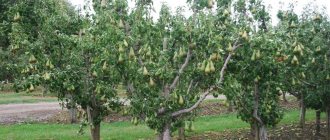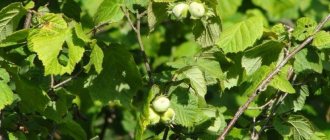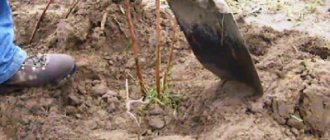Is it possible to grow hazelnuts from nuts?
Hazelnuts are not grown on an industrial scale in Russia. Although there is nothing difficult to grow it in the middle zone and southern regions of the country. If you decide to grow hazelnuts from nuts in the country, then you need to know some planting rules and adhere to them.
The peculiarity of such planting is that the harvest of hazelnuts grown from seeds can be harvested not in the 3-5th year, as in trees grown from seedlings, but in the 6th year or later. Varietal characteristics may also not appear in this case. And this must be taken into account. Therefore, the seed method is more often used by breeders to develop new qualities of hazel.
Comment! Experienced gardeners claim that only selected forms of hazelnuts can be grown with seeds. Hybrid forms should be propagated vegetatively.
How to plant hazelnuts from nuts
There are several ways in which hazelnuts can be grown. The nut method is the simplest. It is carried out in spring or autumn. Autumn planting of hazelnuts should be done about a month before frost and snowfall. Seeds are planted at the rate of 50 nuts per 1 square meter. m, deepened into the soil by 7-8 cm.
If for some reason it was not possible to plant hazelnut seeds in open ground in the fall, then before spring planting the nuts must undergo stratification to improve germination.
To grow hazel, you can plant seeds either as seedlings or in open ground. If after stratification the seedlings turned out to be rare or there were none at all, you need to wait until next spring. Perhaps the nuts have not undergone the necessary stratification, and this will happen in winter.
Selection of planting material
The selection of nuts should be carried out in September-October. Fruits for planting must be well-ripened, whole, and free from any damage by pests. It is recommended to inspect each nut. There should be no moldy smell from them.
It is hardly possible to find the necessary planting material on the market. It is better to purchase it from gardening farms or nurseries. You can borrow from the garden of a gardener you know who grew a hazel tree on his own.
In the fall, before planting the seeds in the ground, it is advisable to treat the fruits with kerosene against rodents.
Hazelnut stratification
Before spring sowing, seeds must undergo stratification for 3-4 months. The procedure is as follows:
- The nuts are soaked in water for 5 days.
- A layer of wet sand and nuts is poured alternately into a container (a wooden box or a plastic bucket), thus mixing the nuts with the sand.
- The container is taken out into a room where the temperature is within +2… +50C.
- Periodically check the condition of the nuts, mix them with sand once every 10-15 days.
The ratio of sand and nuts should be 3:1. The container must have holes for oxygen to enter.
Attention! If the seeds begin to germinate too quickly, they should be taken to a colder place, only one so that the sand does not freeze and the nuts do not die.
Soil preparation
Hazelnuts are unpretentious to soil conditions. It can grow in different types of soil. The main thing is that these soils are not too clayey, swampy, saline or dry sandy. If groundwater passes above 1.2 m underground, then there is a possibility of rotting of the hazelnut root system.
Growing hazelnuts is equally easy both on the plain and on the slopes. It is specially planted to stop soil corrosion. If the soil is infertile, then its composition can be adjusted by adding the missing elements to it in advance: slaked lime or wood ash is added to too acidic soils, chernozems are mixed with compost and sand.
A place is chosen without drafts with good sunlight, but not on the south side. When exposed to spring sun, the buds will grow quickly in the spring and then die when frost returns.
How to plant hazelnut seedlings
In the spring, after 4 months of stratification, when the nuts have begun to germinate, they should be planted in pots or in a box for seedlings. The usual landing rules:
- Prepare a wooden box or pots.
- A fertile composition of sand, humus and earth is poured.
- Make a recess of 6-7 cm.
- Place the nuts in them on their side, since germination occurs through the nose of the fruit.
- Cover with soil and water.
- Cover with film and place in a warm place for several days.
Seeds are sown for seedlings in rows with a distance between nuts of 8-10 cm, between rows - 35 cm. In this case, as the seedlings grow, they will not interfere with each other.
How to properly plant hazelnuts in open ground
Nuts are planted in open ground in the fall, a month before snow falls, or in the spring, in soil that has already been warmed up and dug up in advance. Spring planting is carried out with nuts that have undergone stratification. The algorithm is the same in both cases:
- Make grooves as deep as the width of your palm.
- Place the nuts on their sides at a distance of about 8 cm from each other if you plan to grow them in this place until they are 2 years old. If this place is intended for 3 years of seedling life, then the distance should be greater.
- Sprinkle the nuts with about 1-2 cm of soil.
- Water immediately after planting and repeat after a week.
- Cover with film to create a greenhouse effect.
In spring, the film is periodically removed for ventilation and removed completely when unnecessary.
Hazelnut seedlings that have been grown in pots from seeds are planted in open ground, taking into account that the distance between them should be approximately 5 m, since the hazel tree grows in width.
Pit preparation
Most often, hazelnuts are planted in the spring, but it is better to do this at the end of September or October. At this time, the soil is still moist and has not yet cooled down. Planting pits for planting seedlings are prepared in about a month.
The holes should be made about 0.5 m wide and deep. A mixture of the following is poured into each hole to increase soil fertility:
- compost, humus or manure (2-3 buckets);
- fertilizers, you can take superphosphate (200 g);
- mycorrhizae;
- potassium salt (50 g).
If you initially improve the nutritional properties of the soil, in the next 3 years the plants will not need feeding. The mixture is mixed with the soil directly in the hole. Then a small mound is formed from it. It is in it that the root system of the seedling will need to be distributed.
A wooden stake is driven into the center of each hole. The pegs will become supports for young seedlings. In the future, adult bushes will hold branches on their own.
Important! If the area where hazelnuts will be planted is heavily infested with cockchafer larvae, it must first be treated with chemicals. In another case, you can pre-sow the ground with buckwheat or lupine a year before planting hazelnuts.
Caring for young seedlings
A year after planting the nuts, the young seedlings grow to a height of approximately 15 cm and a stem thickness of 3 mm. In this case, they can already be transplanted to a permanent place. If the seedlings have not reached this size and look weak, then it is better to postpone the transplant to next year.
To grow hazelnuts from nuts at home, you need to provide appropriate care for the seedlings, which includes:
- regular watering;
- fertilization;
- pruning;
- prevention against pests and diseases.
Weeding and mulching
To combat weeds that grow throughout the growing season, the soil in the tree trunk circle is loosened several times during the growing season for the first 5-6 years. It is necessary to loosen the soil in the tree trunk to a depth of 5-7 cm, no more, since the bulk of the roots occur at a depth of up to 20 cm of soil. The trunk circle should be no less than the diameter of the crown.
After the age of fruiting, they stop loosening the soil in the tree trunk circle so as not to injure nearby roots and not disrupt the process of fruit ripening.
Subsequently, the ground is mulched with dry grass, wood chips or other mulch, which protects the tree trunk from weathering, drying out, and freezing.
Watering and fertilizing
Hazelnuts are known as a moisture-loving plant. Its fruiting largely depends on the supply of water. But too much moisture can cause the tree to grow sick and weak.
In dry climates, hazel trees need to be watered regularly, at least 1-2 times a week. In the Moscow region, 1-2 times a month in the spring-autumn period and 3-4 times a month in the summer are enough. Hazel loves irrigation, which almost doubles its yield. To grow hazelnuts, one tree needs to receive 750 mm of rain per year. Based on this, you can calculate how much water to water hazelnuts, if you subtract natural precipitation from this.
From the moment the tree begins to bear fruit, 1-2 buckets of organic fertilizers (humus) are applied annually to each hazel tree. During fruit set, urea is added. In the fall, it would be useful to pour wood ash into the tree trunk circle.
Important! If the soil is fertile, then applying nitrogen fertilizers during the growing season is not recommended. Otherwise, the plant will grow actively, but fruiting will be significantly reduced.
Trimming and shaping
Hazelnut pruning is carried out for the same purpose as for other crops. It allows you to grow a tree with specified parameters, regulate growth, development, fruiting, life expectancy, and productivity.
Thinning the bushes creates a light, well-lit crown. This stimulates the growth of young shoots with fruit buds.
Pruning happens:
- post-landing;
- sanitary;
- rejuvenating;
- formative.
The first pruning is done after planting the seedling. Pruning branches depends on the root system - the denser the fine roots, the fewer branches and leaves need to be trimmed. And, conversely, the fewer fine roots, the stronger the pruning should be. This will help grow a strong root system.
Formative hazelnut trimmings come in two types: tree-like and bush-like. Sanitation is often carried out in the spring to remove diseased, frozen and dry branches. Anti-aging pruning is done on hazelnut trees after 15-20 years of age.
Protection from diseases and pests
Hazelnuts are resistant to diseases and pests. Gardeners have noted that a tree becomes susceptible to fungal diseases if it grows in a wetland or is watered abundantly. In this case, you have to fight infectious diseases.
The main pests that attack hazelnuts include:
- mouse-like rodents;
- spotted woodpeckers;
- proteins;
- wild boars;
- aphid;
- beetles;
- caterpillars.
The most dangerous pests for hazelnuts are the nut weevil and the nut beetle. Digging the soil, collecting affected fruits, and spraying the tree before the beetles lay eggs are used against the weevil. To combat barbel, treat hazelnuts with a 1% solution of colloidal sulfur.
For preventive purposes in the fall, after the leaves fall, all fallen leaves are collected and burned. Then they dig up the ground under the tree. Also, in order to grow healthy hazelnuts, it is necessary to treat them 2 times a year with special fungicides and insecticides, which will free you from unnecessary hassle in case of diseases.
Preparing for winter
For the first 2-3 years, young plants are covered with covering material for the winter so that they do not freeze. In the future, hazelnuts do not require shelter during the onset of cold weather. It must be remembered that you should not apply abundant nitrogen fertilizers and water hazelnuts in late summer and autumn. Otherwise, young shoots will begin to grow in large numbers, will not have time to become woody before the snow falls and will freeze out.
Watering and fertilizing
In dry weather, watering the shrub is required twice a month. A godsend will be the arrangement of drip irrigation. Excess water will harm hazelnuts; introducing drainage would be an excellent solution. Be sure to feed the culture. The type of fertilizer and its amount depends on how fertile the land is. Mineral supplements should be added annually to increase hazelnut growth. At the beginning of summer, the bush is fed with a urea solution. Fertilizer is added when digging up the soil under the crop. When feeding fertile soil, the bush will actively grow, which will reduce the yield.
The bush is constantly attacked by insects. Pest control should begin in the spring. The area is dug up, nuts and insects are collected, and the bush is treated with chemicals.
Advice from experienced gardeners
Before you start growing hazelnuts from nuts at home, you should familiarize yourself with the experience of those who have already done this on their site. Here are some tips for successfully cultivating hazelnuts:
- You should not plant wild hazel in your garden - it produces small fruits. But you can use hazelnuts to grow hazelnuts. To do this, a productive hazelnut variety is grafted onto it.
- It is better to plant hazelnuts in autumn. This crop has a short dormant period, so when planted in spring, most of the seedlings do not take root.
- You should not get carried away with fertilizing the soil. Too rich black soil will stimulate the growth of branches and leaves, which will reduce hazelnut yield.
- To successfully control weeds, you can grow some crops under the hazelnut tree, for example, cereals, vegetables, grass.
The advice gardeners share with each other often helps them avoid repeating their mistakes.











